Italeri 1/72 Eurofighter EF 2000B
|
KIT #: |
? |
|
PRICE: |
6 Euros |
|
DECALS: |
One option |
|
REVIEWER: |
Carmel J. Attard |
|
NOTES: |
Injection moulded kit with prototype decals for the 2-seat version |
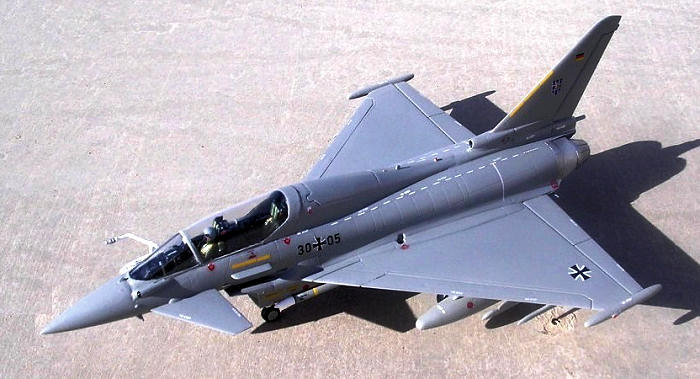
The new
multi-role EF-2000 fighter is a development by a consortium of British, German,
Italian and Spanish industries. There were delays of economical and technical
nature at first and several prototypes have been built in the late nineties.
Following the single seat version, a twin seat variant was designated for pilot
training and precision missile attack missions. It has the same air to air
combat features as a fighter, but is equipped with specialised electronic gear.
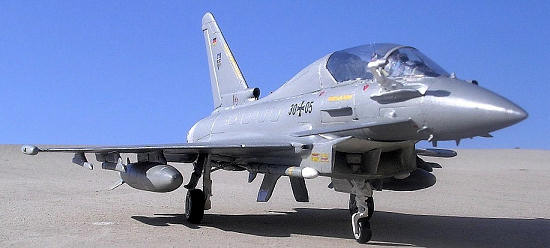 By
the summer of 2006 the four air forces has flown over 9600 hours in the Typhoon
and 84 aircraft had been delivered to the 4 nations, 23 of these went to
Germany.
The Luftwaffe received its first Eurofighter in August 2002 prompting conversion
from Mig 29 by JG 73 in April 2003. In July 2006 JG
74
traded in
their F-4F ICE Phantom IIs for
the
Eurofighter to form
Germany’s
first operational squadron at Neuburg Air Base.
Germany
intends to operate 135 EF 2000 in Air Defence role. These have already replaced
the small fleet of ageing Mig 29s inherited with unification of
Germany
in 1989 and will also replace Germany F4F Phantoms. 40 other EF 2000 will assume
multi-role operations, replacing the Tornados IDS and ECR attack which will be
due for retire in 2012. Other Luftwaffe squadrons set to receive the jet are
Jadgbombergeschw
By
the summer of 2006 the four air forces has flown over 9600 hours in the Typhoon
and 84 aircraft had been delivered to the 4 nations, 23 of these went to
Germany.
The Luftwaffe received its first Eurofighter in August 2002 prompting conversion
from Mig 29 by JG 73 in April 2003. In July 2006 JG
74
traded in
their F-4F ICE Phantom IIs for
the
Eurofighter to form
Germany’s
first operational squadron at Neuburg Air Base.
Germany
intends to operate 135 EF 2000 in Air Defence role. These have already replaced
the small fleet of ageing Mig 29s inherited with unification of
Germany
in 1989 and will also replace Germany F4F Phantoms. 40 other EF 2000 will assume
multi-role operations, replacing the Tornados IDS and ECR attack which will be
due for retire in 2012. Other Luftwaffe squadrons set to receive the jet are
Jadgbombergeschw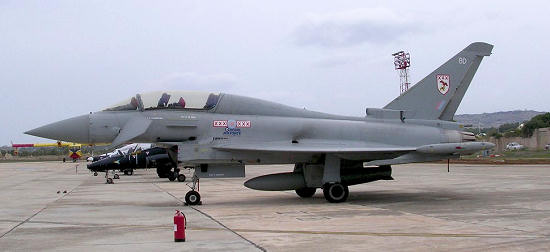 ader
31 at Norvenich Air Base, Jbg 33 at Buchal Air Base and Jbg 71 at Wittmund Air
Base.
ader
31 at Norvenich Air Base, Jbg 33 at Buchal Air Base and Jbg 71 at Wittmund Air
Base.
In
late September this year two, two-seat Typhoon visited
Luqa,
Malta,
for the first time ever. These belonged to 23 Squadron RAF. They left Akrotiri
air base in
Cyprus
and came in for the annual air show, one arriving on Friday 26th September,
and the other on Saturday 27th. On Saturday afternoon one of these
performed a fighter type aerobatic display over
St Paul’s
Bay. After the show the two Typhoons left Luqa in a low but fast and loose
formation on their way to
Barcelona,
again to take part in an air show.
This is a
very detailed kit of the 2-seat version of the Eurofighter. Other kits of the
Eurofighter have already appeared depicting the aircraft at different stages
during development and although the Italeri kit is not quite to the production
version standard the re
is a way to add the required changes so that I could represent my kit of the
Eurofighter to the standard that it appeared in service with JG 73
'Steinhoff
Laage',
at Berlin in May 2006.
re
is a way to add the required changes so that I could represent my kit of the
Eurofighter to the standard that it appeared in service with JG 73
'Steinhoff
Laage',
at Berlin in May 2006.
The kit is moulded in light grey plastic; free from flash
and has engraved panel lines.
There
is painting instructions on parts as you go along with the kit assembly. Both
cockpit instrument panels are embossed which make it easy to hand paint although
at this scale one may prefer to use decal sheet with printed instruments. There
are two large under wing tanks and six AIM-120 missiles and twp AIM-9L/M
sidewinders. The nose mounted refuelling probe can be assembled in the extended
position and on the whole it is a straight forward kit with a crystal clear
canopy that reveals any extra work that one could add to the cockpit interior.
The decal sheet is somewhat brief with markings looking grossly oversize to me.
I put away in preference to others from my spares box. The kit sheet caters for
a British or an Italian machine.
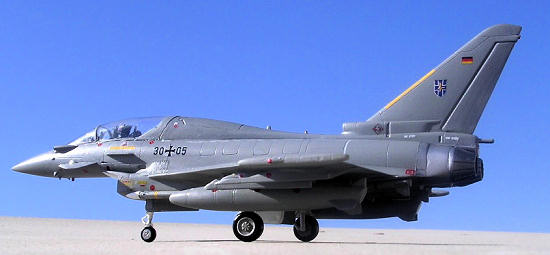 The
first stage of construction concerned the cockpit where separate throttles,
instrument panels, control sticks, seats are provided. The crew seats are rather
simple and come in separate pieces with harness detail moulded on. The dark gull
grey cockpit consists of nine items which are put together and painted before
transferred to one side of the fuselage. I added side console decal instruments
using Eurofighter decal spares. Nose weight added to nose cone to ensure it
stands on the nose wheel. The air brake aft of cockpit can be fitted extended or
closed. The main wing parts come in three separate items and are assembled
complete with an interior blanking plate, and wing tip ecm fairings.. The
consoles are glued in one position while the 3 part jet pipe nozzles, which come
in closed configuration, are fixed in place. The rest of assembly consists of
adding the undercarriage and wheel well doors and refuelling probe that I
preferred to assemble in the extended position to show some indication of detail
to overcome the overall impression that the design of a modern fighter seems to
lack.
The
first stage of construction concerned the cockpit where separate throttles,
instrument panels, control sticks, seats are provided. The crew seats are rather
simple and come in separate pieces with harness detail moulded on. The dark gull
grey cockpit consists of nine items which are put together and painted before
transferred to one side of the fuselage. I added side console decal instruments
using Eurofighter decal spares. Nose weight added to nose cone to ensure it
stands on the nose wheel. The air brake aft of cockpit can be fitted extended or
closed. The main wing parts come in three separate items and are assembled
complete with an interior blanking plate, and wing tip ecm fairings.. The
consoles are glued in one position while the 3 part jet pipe nozzles, which come
in closed configuration, are fixed in place. The rest of assembly consists of
adding the undercarriage and wheel well doors and refuelling probe that I
preferred to assemble in the extended position to show some indication of detail
to overcome the overall impression that the design of a modern fighter seems to
lack.
In
order to build the production version that I had in mind to represent one that I
spotted in a side view I picked from SAM issue dedicated to the Eurofighter Vol
28 No 12 Feb 2007, this required some alterations. The side view appears on
P.796 showing the type in German markings with registration 30+05 and belonging
to JG 73 Laag based in
Berlin.
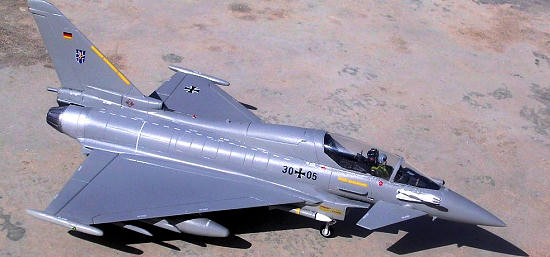 The
first alteration consisted of removing two small air intakes located under the
rear of wings and blanked the area with filler. I also blanked the front of two
small intakes that should be outlets instead which were altered to look so. The
nose wheel door was reshaped so that the front edge is curved, this also meant
to alter the corresponding wheel well front.. The kit nose cone had a small
upper fairing that was filed off and sanded smooth. There are two rear engine
blisters that come as separate parts No 26b which should be left out. The heat
seeking sensor fairing part 27b is shortened at front before it is fixed to the
nose. I also shaped a tiny outlet scoop from plastic sprue which I then added to
upper fuselage ahead of exhaust outlets. A rectangular blade antenna was added
under the air intake offset to the left. The pointed nose of the 1,000 litre
fuel tanks were reshaped using a flat file. I also added four fins to the rear
of the tanks. These I made from 0.4mm plastic card. The leading edges of main
planes were made thinner by scraping along the edge with an Exacto blade.
Finally I modified the spare under wing pylons for AMRAAM missiles and fitted to
space in line with outer flap actuator fairings. A pair of straight rails were
shaped and added to these pylons. Other smaller refining to the kit included
detail portions added to the wing tip system pods, and triangular shaped antenna
to the nose /data probes under the nose cone.
The
first alteration consisted of removing two small air intakes located under the
rear of wings and blanked the area with filler. I also blanked the front of two
small intakes that should be outlets instead which were altered to look so. The
nose wheel door was reshaped so that the front edge is curved, this also meant
to alter the corresponding wheel well front.. The kit nose cone had a small
upper fairing that was filed off and sanded smooth. There are two rear engine
blisters that come as separate parts No 26b which should be left out. The heat
seeking sensor fairing part 27b is shortened at front before it is fixed to the
nose. I also shaped a tiny outlet scoop from plastic sprue which I then added to
upper fuselage ahead of exhaust outlets. A rectangular blade antenna was added
under the air intake offset to the left. The pointed nose of the 1,000 litre
fuel tanks were reshaped using a flat file. I also added four fins to the rear
of the tanks. These I made from 0.4mm plastic card. The leading edges of main
planes were made thinner by scraping along the edge with an Exacto blade.
Finally I modified the spare under wing pylons for AMRAAM missiles and fitted to
space in line with outer flap actuator fairings. A pair of straight rails were
shaped and added to these pylons. Other smaller refining to the kit included
detail portions added to the wing tip system pods, and triangular shaped antenna
to the nose /data probes under the nose cone.
The
interiors of wheel wells and intake were painted Humbrol white; the exhaust
nozzles were a mix of silver, black and matt varnish. These places were masked
with tape as was also the clear canopy which was now firm in place.. The rest of
the aircraft painted in overall dark ghost grey. Sliding areas on the white oleo
legs and refuelling probe were painted silver. German markings and decals came
from spares box.
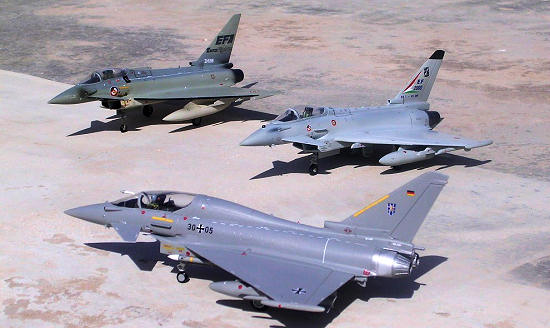 In
general this was not a complex update and maybe also within anyone’s reach, but
in doing so one opens the chances for a wider spectrum of markings on production
version of the Eurofighter that is now starting to emerge at a quick pace in
European skies.
In
general this was not a complex update and maybe also within anyone’s reach, but
in doing so one opens the chances for a wider spectrum of markings on production
version of the Eurofighter that is now starting to emerge at a quick pace in
European skies.
Carmel J. Attard
October 2008
Copyright ModelingMadness.com. All rights reserved.
If you would like your product reviewed fairly and fairly quickly, please
contact the editor or see other details in the
Note to
Contributors.
Back to the Main Page
Back to the Review Index Page
2021




 re
is a way to add the required changes so that I could represent my kit of the
Eurofighter to the standard that it appeared in service with JG 73
'Steinhoff
Laage',
at Berlin in May 2006.
re
is a way to add the required changes so that I could represent my kit of the
Eurofighter to the standard that it appeared in service with JG 73
'Steinhoff
Laage',
at Berlin in May 2006. The
first stage of construction concerned the cockpit where separate throttles,
instrument panels, control sticks, seats are provided. The crew seats are rather
simple and come in separate pieces with harness detail moulded on. The dark gull
grey cockpit consists of nine items which are put together and painted before
transferred to one side of the fuselage. I added side console decal instruments
using Eurofighter decal spares. Nose weight added to nose cone to ensure it
stands on the nose wheel. The air brake aft of cockpit can be fitted extended or
closed. The main wing parts come in three separate items and are assembled
complete with an interior blanking plate, and wing tip ecm fairings.. The
consoles are glued in one position while the 3 part jet pipe nozzles, which come
in closed configuration, are fixed in place. The rest of assembly consists of
adding the undercarriage and wheel well doors and refuelling probe that I
preferred to assemble in the extended position to show some indication of detail
to overcome the overall impression that the design of a modern fighter seems to
lack.
The
first stage of construction concerned the cockpit where separate throttles,
instrument panels, control sticks, seats are provided. The crew seats are rather
simple and come in separate pieces with harness detail moulded on. The dark gull
grey cockpit consists of nine items which are put together and painted before
transferred to one side of the fuselage. I added side console decal instruments
using Eurofighter decal spares. Nose weight added to nose cone to ensure it
stands on the nose wheel. The air brake aft of cockpit can be fitted extended or
closed. The main wing parts come in three separate items and are assembled
complete with an interior blanking plate, and wing tip ecm fairings.. The
consoles are glued in one position while the 3 part jet pipe nozzles, which come
in closed configuration, are fixed in place. The rest of assembly consists of
adding the undercarriage and wheel well doors and refuelling probe that I
preferred to assemble in the extended position to show some indication of detail
to overcome the overall impression that the design of a modern fighter seems to
lack.
 In
general this was not a complex update and maybe also within anyone’s reach, but
in doing so one opens the chances for a wider spectrum of markings on production
version of the Eurofighter that is now starting to emerge at a quick pace in
European skies.
In
general this was not a complex update and maybe also within anyone’s reach, but
in doing so one opens the chances for a wider spectrum of markings on production
version of the Eurofighter that is now starting to emerge at a quick pace in
European skies.